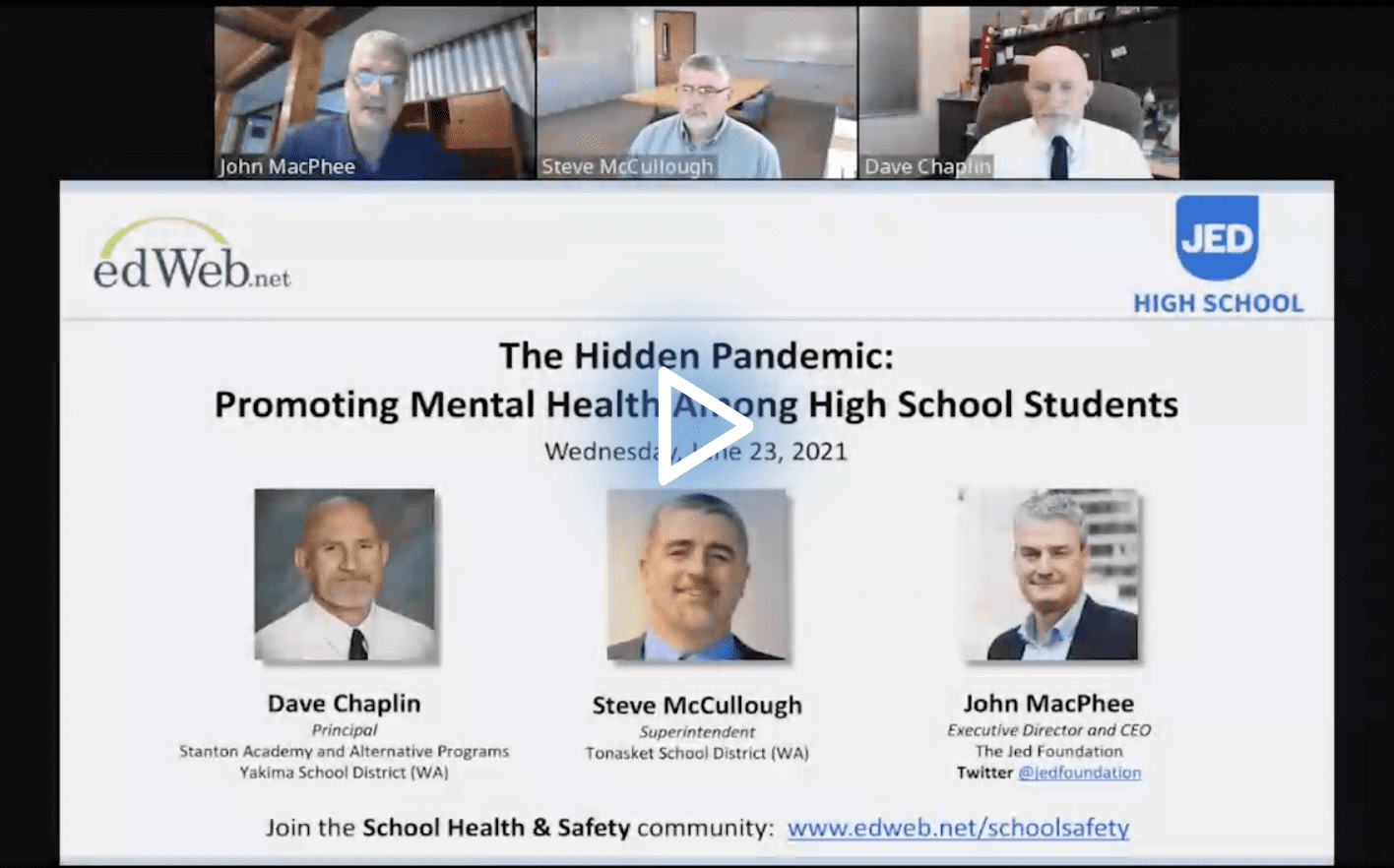Striving to Keep Students Mentally Healthy
The Tonasket School District (WA) experienced two student suicides in the last three months, surprising everyone. Steve McCullough, the district superintendent, described the students as active in high school and great athletes with bright futures. Nobody thought they had any problems.
The suicides are among related incidents that have occurred in the district. McCullough, like other educational administrators nationwide, is navigating a mental health crisis among high school teens. The toll is substantial, and the capacity to provide necessary supports is difficult.
Schools can be a source of mental health support, as discussed in the edLeader Panel, “The Hidden Pandemic: Promoting Mental Health Among High School Students,” sponsored by The Jed Foundation. McCullough and Dave Chaplin, Principal of Stanton Academy and Alternative Programs in the Yakima School District (WA), discussed their efforts—in partnership with The Jed Foundation—to ensure students’ well-being now and into the future.
The State of Teens’ Mental Health
The COVID-19 pandemic heightened mental health challenges across the nation, especially among young people, explained John MacPhee, Executive Director and CEO of The Jed Foundation. “Teens and young adults are contending with a tremendous sense of loss, loneliness, uncertainty, disruption and stress. In addition, the increasing rates of anxiety and depression are of serious concern.”
Schools particularly are experiencing more and more students with mental health challenges. MacPhee highlighted findings of a Jed Foundation study of 450 school administrators that underscore the problem’s scope:
- 60% of administrators say that mental health concerns have been rising over the last several years.
- 53% view suicidal thoughts as a moderate or major concern.
- Nearly half indicate that a suicide attempt or death has occurred recently at their school (public school administrators from the Midwest and the suburbs and in schools that index higher for eligible free or reduced lunch see more suicide attempts or deaths).
Help is available, but students often don’t pursue it for several reasons, explained MacPhee. Embarrassment tops the list, followed by teens not even aware that they have a mental health issue. And then there is the fear of getting into trouble. Compounding these concerns are the classic stigma of shame, prejudice and not wanting to be a burden.
Partnering with The Jed Foundation: Exploring Mental Health from Within
The Jed Foundation partners with school districts and high schools through its JED High School Program to evaluate and strengthen programming and systems related to suicide prevention, mental health and substance misuse prevention.
The work to support struggling students is extensive, explained MacPhee. “How do you connect them to mental health care? What’s available in school? What’s available in the communities? How do you interface with families? How do you prepare for crises in advance? And how do you do all of this work in a way that’s strategic and equitable?”
Finding the answers, emphasized MacPhee, requires senior educational leaders committed to addressing mental health and creating a long-term sustainability plan for ongoing services and supports.
McCullough and Chaplin are exemplary leaders in this regard. They worked with The Jed Foundation to discover and dive deeply into their students’ mental health challenges and address them through expanded supports.
Identifying Challenges and Finding Solutions
Stanton Academy
At Stanton Academy, a primarily low-income student body faces many obstacles, all potential contributors to a mental health decline. There are students who:
- Have difficulty maneuvering within the school system
- Live in an urban environment with a high gang presence and violence
- Reside in low-income housing
- Transition in and out of incarceration or serve stints in the local juvenile detention center, Juvenile Administration facility, juvenile rehabilitation program or halfway house
- Have been suspended long term or expelled but for whom the state requires the provision of educational opportunities
Students experience significant anxiety due to these circumstances; they worry about coming to school or being bullied or harassed. In addition, the pandemic exacerbated anxiousness—many students wondered how they would get their next meal and wash their clothes.
It was Stanton’s security guard who made sure students had access to food and laundry facilities and who traveled, with the school’s social-emotional specialist and teachers, to deliver food to and connect with students experiencing trauma in the community and at home. She did the same with students in the juvenile detention center while connecting with families of incarcerated teens.
As the school moved out of the COVID lockdown, a staggered schedule enabled students to participate in an onsite tutorial program, which allowed school staff to connect with and support their socio-emotional well-being. But when the entire student body returned to Stanton, students felt disconnected socially.
In addition to designing ways for students to connect better, Stanton has launched initiatives to ensure students stay safe and healthy in school. The efforts include:
- Hiring two case managers to work with at least 50 high-needs students.
- Initiating Multi-Tiered Systems of Support (MTSS) to identify and address intervention levels for struggling students.
- Partnering with a Yakima community center where students accessed tech support during the pandemic, allowing them to transition back to school full time. In addition, the center has a food pantry and provided the school with food boxes to deliver to students.
- Partnering with the local lending institution that quarterly donates $2,500 to the school to purchase food for students. With the funding, the school installed an industrial washer and dryer where students can launder clothes (and if they can’t, someone in school does it for them).
Tonasket School District
The Tonasket School District is in a rural town and with that comes a poverty rate of 80%. Rural poverty presents unique challenges. In Tonasket, these include:
- A lack of public transportation prevents some students (like those who live about 30 miles down dirt roads, essentially off the grid) from getting access to the resources they need. Just traveling by bus to school takes an hour each way.
- A bootstrap mentality in the community where getting mental health support is a sign of weakness, coupled with the fear of mental health issues becoming public knowledge.
- A pervasive lack of mental health understanding and thus the inability to help someone struggling with mental health issues, like suicide ideation.
- Poor quality healthcare and a lack of qualified and skilled healthcare professionals.
- Lack of internet access that allows people to participate in teletherapy. For students, school is the primary place to go for help.
- A high rate of drug and alcohol use along with substantial recreational drug use and self-medication among students and parents.
- Marginalized students don’t have role models.
“There was a recent audit of student behavioral health in K-12 education by our Washington auditor,” said McCullough. “It stated that the state’s current approach is fragmented, with roles and responsibilities assigned across several local and state agencies. I just echo that our efforts are fragmented for our county and our community, and it’s not effective. We don’t have access to the resources and there’s no coordination of those resources.
“But,” he emphasized, “we do have pockets of greatness.” Those pockets rest in the Tonasket schools that, according to McCullough, are the most trusted institutions (that serve as safety nets) in terms of relationships with students. The schools support students in the following ways:
- Each school has a counselor; the counselors network frequently and join forces when there is a crisis.
- The teachers regularly reach out and care for students.
- The district has a strong migrant parent outreach program, with over 200 people coming to monthly meetings.
- Students participate in two social-emotional programs, Second Step and CharacterStrong. And the district has recently begun implementing restorative justice practices.
The Tonasket community itself is a substantial resource, especially during crises like Washington State’s horrific wildfires. McCullough described how people across the community come together in such times. “We need to take that community spirit,” urged McCullough, “and channel it to the mental health crisis we’re experiencing.”
Tips for Launching Mental Health Support
McCullough and Chaplin admit that they have to establish more robust and sustainable mental health services and support that require more resources than they currently have. But, what they’ve learned through their work with The Jed Foundation and the impact they’ve had indicates they are on the right track. They offered tips for educational leaders who want to travel a similar path to improve students’ well-being:
- Form a team to address mental health, which includes students.
- Know the student population and communities where they live to recognize their differences and develop empathy for students whose surroundings may be challenging.
- Ensure that students and staff connect, that there is someone at the school who can reach out to a student to find out, for example, why they are coming to school and what makes them tick.
- Make sure leadership teams share with administrators what is and is not working with interventions and services.
- Provide professional development and training that guide teachers in creating appropriate classroom cultures and attitudes to recognize and support learners with mental health needs.
- Remove barriers to activities that benefit students, e.g., eliminate athletic fees so students can participate on sports teams that generate community and positive social interactions.
- Reach out continually to relevant local organizations to form effective partnerships to sustain existing programs, and leverage those partnerships once formed.
- Pursue levy funds when possible to pay for school counselors.
Chaplin and McCullough fully represent The Jed Foundation’s stance on mental health: It belongs to everyone and there’s no wrong-door approach to aim for to address it.
This edWeb broadcast was sponsored by The Jed Foundation.
Watch the Recording Listen to the Podcast
About the Presenters
Dave Chaplin has worked in the Yakima School District for 38 years. For 20 years, he was a teacher and has been an administrator for the past 18 years. His administrative experience includes schools that serve students with many needs that are not met through traditional education. For the past seven years, Dave has worked in the district’s Alternative Programs, which include a comprehensive high school, incarcerated youth, and long-term suspended or expelled students.
Steve McCullough has been an educator for the past 26 years, serving as a teacher, principal, and superintendent in rural eastern Washington, and is currently in his sixth year as Superintendent at the Tonasket School District. Prior to working in public education, Steve was an employee benefits consultant for Hewitt Associates. Steve has a BA in economics from PLU, an MA in education psychology from Pacific Lutheran University, his principal credentials from Eastern Washington University, and his superintendent credentials from Washington State University. Steve also serves on several regional and state committees, including the Rural Alliance and the Rural Education Center.
John MacPhee brings 25 years of leadership and management experience from the business and not-for-profit settings to his role as Executive Director and CEO of The Jed Foundation. Passionate about supporting young adults in their transition to adulthood, John advises several organizations including City College’s S Jay Levy Fellowship for Future Leaders, Trek Medics, Crisis Text Line, Mailman School of Public Health’s Department of Health Policy and Management, and HIV Hero. John continues to contribute to the development of novel medications for disorders such as Parkinson’s disease through board roles with Adamas Pharmaceuticals and Blackthorn Therapeutics.
In 2016, John received The Allan Rosenfield Alumni Award for Excellence in the field of public health from the Joseph L. Mailman School of Public Health at Columbia University. He earned a BA from Columbia College, an MBA from New York University, and an MPH from Columbia University.
Join the Community
School Health & Safety is a free professional learning community on edWeb.net that provides educators, school staff, school leaders, and district administrators with a forum to collaborate and discuss the issues and practices that can keep schools, students, and staff healthy and safe.
The Jed Foundation (JED) helps schools evaluate and strengthen their mental health, substance abuse and suicide prevention programs and systems to safeguard individual and community health. We also develop resources and partnerships to ensure teens and young adults have access to resources and support to navigate life’s challenges.
The summary of this presentation was written by Michele Israel.
Michele Israel writes about the ideas and best practices that are shared in edWeb’s edWebinars so they can spread innovative and best practices to the education community. Michele owns Michele Israel Consulting, LLC, which serves large and small educational, non-profit, media, corporate, eLearning, and blended learning organizations to bolster products and programs. Her rich career spans over 25 years of successfully developing educational materials and resources, designing and facilitating training, generating communication materials and grant proposals, and assisting in organizational and program development. In addition to lesson plans and other teacher resources, Michele’s portfolio includes published articles covering a range of educational and business topics.





Comments are closed.